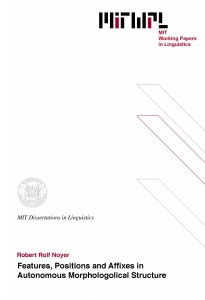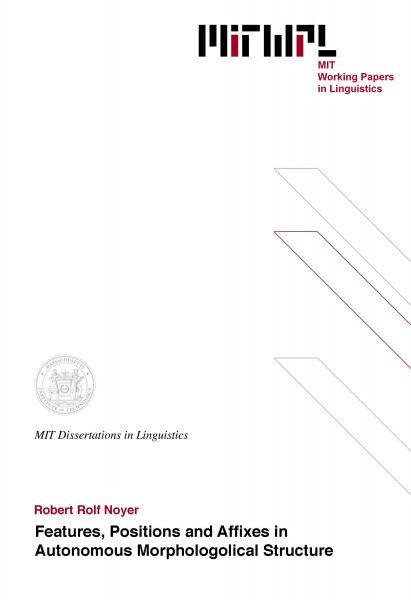Features, Positions and Affixes in Autonomous Morphological Structure
R. R. Noyer, 1992
This thesis develops a theory of the mapping from the output of syntactic rules to the input to phonology within a component of Morphology. Three types of information are shown to be independently manipulable in the algorithm deriving fully inflected words: morphosyntactic features, phonological material (affixes), and positions-of-exponence.
To capture categorial neutralizations at the morphological level, a filter-based approach to the Impoverishment of morphosyntactic representations is proposed. Filters are argued to be automatically assumed unless positive evidence suppresses them in the learner. Neutralizations are also shown to occur at three other levels: (1) underspecification of realization rules/affixes, (2) disjunction of affixes competing for a position-of-exponence, and (3) transparency of redundant morphosyntactic values. A hierarchy of features is proposed, which, in the unmarked instance, governs the direction of categorial neutralization and the ordering of affixes and morphological rules, where not determined by syntax or by the principle of descending complexity due to Panini.
The mapping to phonological form is proposed to take place in two phases. In the first phase, morphosyntactic well-formedness is established through the Impoverishment of morphosyntactic features and the Linearization, Rebracketing, Merger (Marantz 1988) and Fusion of syntactic heads, giving a level of constituents termed M0s. In the second phase, the M0 string is mapped to the well-formed morphological word through rules and affixes. Morphological words are shown to display idiosyncratic non-phonological conditions of well-formedness (obligatory or limited positions-of-exponence) which comprise autonomous morphological structure. Particular attention is paid to cases of M0 splitting, where features from a single morphosyntactic source are realized at multiple positions.
Features in input morphosyntactic representations are argued to be discharged through the instantiation of affixes, sometimes at obligatory positions-of-exponence, which are also then discharged. This discharge constitutes spell-out or realization of phonological material. Because both features and positions may be discharged independently, it becomes possible to express disjunctions across position classes, termed here discontinuous bleeding. Further, the Rule-Affix Hypothesis states that rules change phonological material and do not discharge morphosyntactic features; affixes add phonological material and do discharge such features.
The Introduction situates the current proposal within prevailing theories of inflection, Lieber (1980, 1992), Anderson (1981, 1992), and Halle (1989a, 1992). Chapter 1 exemplifies the theory through a detailed analysis of the Afroasiatic prefix-conjugation. Chapter 2 gives an explicit theory of person-number features and their interpretation, in particular the inherent number system of Kiowa-Tanoan. Chapter 3 treats complex multiple argument agreement systems with particular attention to the transitive clitic sequences of Nunggubuyu and Ket.

